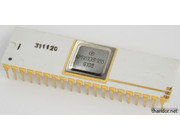An 8086-chip but with 8-bit data bus, and shorter prefetch queue, to create cheaper motherboards. Internally it is 16-bit.
An early 8088 microprocessor with it's date code 8125! This means it rolled of the assembly line in the 25th week of 1981. That's about 2 years after the initial release in 1979.
The 8088 is almost identical to the 8086 except that it has an 8-bit external databus. Internally it can process just as fast as a 8086 but communication to for example RAM is slower. In a lot of cases this doesn't impact performance that much. The reason that the 8088 exists is that motherboards can be produced in a cheaper way because they only need an 8-bit bus.
Many PC's up to even 1990 were equipped with an 8088, 8086 or NEC V20/V30 CPU. My first PC was built in 1988 which is a full 7 years later than this CPU!
Note that the 8088 and 8086 are not interchangeable. They do share the same 40-pin socket and do share the same execution unit but have a different bus unit.
So far this is the oldest x86 CPU in my collection ![]() . > Read more
. > Read more
Just like my other V20 but runs at a faster pace. This 10MHz V20 is fitted onto a Juko ST "TurboXT" motherboard. It's a late 8088-based motherboard and has been manufactured a year after the 486 made it's debut.
In Europe not many TurboXT like these have been sold which makes it a quite rare piece.
Performance wise it runs just a little better than the normal version. See the benchmarks below:
Standard 4,77MHz 8088 : 8 points
Standard 8MHz 8088 : 16 points
Nec V20 8MHz : 22 points
Nec V20 10MHz : 27 points
By far three times faster than the original IBM XT and noticeably faster than the standard 8088 at 8MHz. > Read more
A one-in-million Intel 8088 clone made by Fujitsu. These clones are 100% compatible with the Intel 8088: you can remove the Intel part and install the Fujitsu CPU and your XT will boot up without even knowing that the CPU changed ![]() . > Read more
. > Read more
Kvazar is an Ukrainian manufacturer from the USSR-era. They made perfectly matching Intel 8088 and 8086 clones. As seen on the picture they used white packaging with gold-colored pins. I like that color combination!
I've tested this CPU in my ARC 8088 system and it works as a normal 4,77MHz/5MHz 8088 CPU. The only problem I faced is that my 8088 boots up with turbo mode on (=8MHz) which can only be set back to 5MHz a few seconds after booting. This means I have to boot the CPU overclocked (double the clock frequency as normal!) and set it back to 5MHz before it crashes.
Kvazar also made an 8086 that looks interesting, too. Not white with gold, but black with a separate part in the middle that houses the CPU core. See this link for the 8086 version ![]() . > Read more
. > Read more
One of the faster regular XT processors out there! The NEC V20 is a reversed engineered Intel 8088 processor and is slightly faster despite it runs at 8MHz as well.
I installed the NEC V20 in my ARC ProTurbo 88 system (came with Intel 8088 fitted) and noticed faster boottimes and the CPU seems to run a bit cooler as well. > Read more
This is an Intel 8088 clone running at 5MHz (4,77). It just runs exactly like the Intel chip in terms of performance. The 8088's made my other manufacturers than Intel are not reverse engineering but made with the original spec/design sheets. Intel sold the rights to other companies to fabricate chips because IBM, who selected the Intel chip for it's personal computers, didn't one to rely on one source of chips. > Read more
My first PC had this Intel-clone 8088 8MHz processor. Along with 640KB RAM, 5,25" DD drive and a Seagate ST-225 'tank' it found it's home in an ARC ProTurbo-88. The 8088 is a cheaper variant of the 8086. Whereas the 8086 has a 16-bit I/O interface the 8088 has 8-bit. Because of this motherboard manufacturers could build less complex and thus cheaper motherboards.
The 8086 and 8088 CPU's are found in many old PC's. The IBM 8530 had a 8086 for example. Because IBM's policy was to have more than one supplier of chips, other companies like Siemens and AMD started manufacturing these CPU's as well. That's why many of the 8086/8088 clones also have the Intel-copyright marking printed on.
I consider the 8086/8088 as 'the' start of the modern home computer. Of course there are other models available with different CPU's (like the Motorola 68000) but the 8086/8088 was (and is actually) the foundation of the CPU's today. CPU's like the 286, 386 and today's Intel Core and AMD Phenom / Opteron systems have something in common. The 8088 / 8086 featured an x86-architecture, just like today's CPU's in desktop PC's and many servers. Thanks to this it's possible to run old MS-DOS versions on the latest systems. Also 'thanks' to this some problems occurred because the 8086 / 8088 had limitations in addressing memory. Only true 32-bit operating systems (not MS-DOS (16-bit), nor Windows '95 but Linux, Windows NT and up) escape this problem. > Read more








